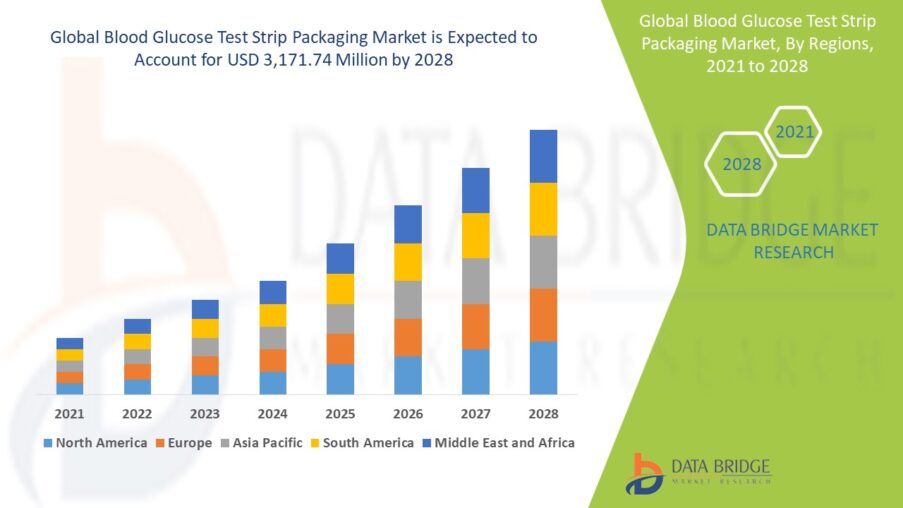Introduction
The blood glucose test strip packaging market is a niche but critical segment of the larger medical device and packaging industry. The packaging not only preserves the chemical integrity of the strips but also influences regulatory compliance, branding, and patient convenience. As the prevalence of diabetes rises globally, so too does the demand for reliable, cost-effective, and user-friendly packaging solutions. Furthermore, increased awareness of sustainability, digital healthcare integration, and product differentiation is pushing manufacturers to innovate in materials, design, and production technologies.
This article explores the landscape of the blood glucose test strip packaging market, including its structure, key drivers, emerging technologies, regional dynamics, competitive landscape, and future outlook.
Market Overview
Blood glucose test strips are highly sensitive devices that use enzyme-based reagents to react with glucose in blood samples. These reactions are susceptible to degradation from light, moisture, temperature, and physical damage. Therefore, packaging serves as the first line of defense to maintain the product’s effectiveness and accuracy. The packaging also plays a significant role in ease of handling, compliance with medical regulations, and reducing contamination or misuse.
The market encompasses various types of packaging, including individual foil wraps, multi-strip canisters, blister packs, and automated cartridge systems. The choice of packaging varies based on factors such as production cost, user demographics, product placement (clinical vs. home use), and regulatory requirements.
This market is characterized by steady growth in demand, driven by both increasing diabetes prevalence and rising self-monitoring behavior among patients. Additionally, innovations in packaging design and materials have enabled manufacturers to differentiate their products, extend shelf life, and improve patient experience.
Key Market Drivers
1. Rising Global Prevalence of Diabetes
According to international health estimates, over 500 million people globally are living with diabetes, and the number continues to grow due to factors like aging populations, sedentary lifestyles, and dietary changes. This expanding diabetic population increases the demand for blood glucose monitoring solutions, including test strips and their packaging.
2. Increasing Adoption of Home-Based Glucose Monitoring
The trend toward patient self-management of chronic conditions has led to greater adoption of home-based glucose monitoring devices. Convenient, portable, and easy-to-use packaging enhances user compliance and minimizes the risk of contamination or misuse.
3. Regulatory Compliance and Product Integrity
Medical packaging is heavily regulated to ensure the safety and effectiveness of the enclosed product. Manufacturers are required to adhere to stringent regulations regarding sterility, labeling, and barrier properties. As regulations become more rigorous, the demand for high-performance, compliant packaging solutions increases.
4. Demand for Extended Shelf Life
Blood glucose test strips often have a limited shelf life due to their enzymatic components. Packaging solutions that offer superior barrier properties against oxygen, moisture, and UV light can significantly extend product shelf life and reduce wastage.
5. Sustainability and Environmental Awareness
As healthcare sectors grapple with rising waste levels, there is growing pressure on packaging manufacturers to adopt recyclable, biodegradable, or reusable materials. Companies are investing in eco-friendly packaging options without compromising barrier performance or regulatory compliance.
Market Segmentation
The blood glucose test strip packaging market can be segmented based on packaging type, material, application, end-user, and geography.
By Packaging Type
-
Foil Wraps: Common for individually packaged strips, especially in tropical or humid regions.
-
Plastic Canisters: Widely used for multi-strip packaging; includes desiccants to absorb moisture.
-
Blister Packs: Offer dose-specific packaging and improved sterility.
-
Cartridge Systems: Used in high-end glucometers with integrated auto-loading features.
By Material
-
Plastic (Polypropylene, PET, PVC): Lightweight and cost-effective, often used in canisters and blisters.
-
Aluminum Foil: Excellent barrier against moisture and oxygen; used in individual strip packaging.
-
Paperboard: Typically used for outer cartons and labeling, contributing to sustainability.
-
Desiccant-Integrated Materials: Used for internal packaging to control humidity.
By Application
-
Self-Monitoring Blood Glucose (SMBG)
-
Point-of-Care Testing (POCT)
-
Hospital Use
-
Pharmacy Dispensing
By End-User
-
Hospitals and Clinics
-
Pharmaceutical Companies
-
Retail Pharmacies
-
Online Distribution Channels
-
Homecare Users
Technological Innovations in Packaging
1. Smart Packaging
Advancements in smart packaging — including embedded sensors, QR codes, and RFID tags — allow real-time monitoring of storage conditions and product usage. These features can remind users when strips are expiring or when reordering is needed, enhancing treatment adherence.
2. Integrated Desiccant Technologies
Desiccants play a vital role in moisture-sensitive packaging. Modern packaging now includes desiccant materials embedded in the packaging walls or lining, reducing the need for loose sachets and simplifying handling for users.
3. Tamper-Evident and Child-Resistant Features
To ensure safety, especially in home settings, packaging designs now often include tamper-evident seals and child-resistant closures. These features are increasingly mandated by regulatory bodies for medical devices and accessories.
4. Easy-Open and Accessibility-Driven Design
Considering the elderly and visually impaired populations, manufacturers are designing packaging with easy-open lids, tactile labeling, color-coding, and larger font sizes to enhance usability and reduce dosing errors.
5. Sustainable Material Alternatives
Biodegradable plastics, compostable films, and recyclable packaging components are becoming more prominent. Some manufacturers are even exploring packaging made from plant-based polymers or ocean-recycled materials.
Regional Market Insights
North America
North America is a dominant region in the blood glucose test strip packaging market, driven by high diabetes prevalence, advanced healthcare infrastructure, and robust regulatory standards. The U.S. leads in terms of market share due to the strong presence of major packaging and diagnostics companies, as well as a proactive patient population that emphasizes home monitoring.
Europe
Europe follows closely behind, with countries like Germany, the UK, and France showcasing a mature market for diabetic care solutions. Environmental regulations in the EU have pushed manufacturers toward sustainable packaging solutions. There’s also growing investment in digital packaging integration.
Asia-Pacific
Asia-Pacific is experiencing rapid market growth, driven by the increasing diabetic population in countries like China, India, and Japan. Rising health awareness, government initiatives for early diagnosis, and the emergence of local manufacturers are creating significant opportunities. Cost-effective packaging solutions are in high demand in this price-sensitive region.
Latin America and Middle East & Africa
These regions are emerging markets with growing healthcare investments and a rising burden of chronic diseases. Challenges remain in the form of affordability, regulatory inconsistencies, and distribution logistics, but the potential for growth is significant with rising awareness and healthcare reforms.
Competitive Landscape
The blood glucose test strip packaging market includes a mix of large medical device manufacturers, specialized packaging companies, and material suppliers. Strategic partnerships, research collaborations, and acquisitions are common strategies used to expand market presence and enhance technological capabilities.
Key Market Players:
-
Major Medical Device Companies: Often develop proprietary packaging for their branded test strips.
-
Pharmaceutical Packaging Firms: Focus on barrier materials, desiccants, and sustainable options.
-
Contract Packaging Organizations (CPOs): Offer flexibility and cost savings for mid-sized and startup firms.
-
Material Innovators: Develop novel polymers, barrier films, and eco-friendly solutions.
Strategic Initiatives:
-
Product Customization: To meet different user needs across various markets.
-
Supply Chain Optimization: Ensuring timely delivery and cost efficiency.
-
Regulatory Compliance: Focus on meeting ISO, FDA, CE, and other medical device packaging standards.
-
R&D Investment: In new materials, user-friendly formats, and smart features.
Market Challenges
1. Stringent Regulatory Environment
Compliance with diverse global regulations can be complex and costly. Labeling, sterility, and material safety requirements vary across regions, necessitating localized solutions.
2. High Cost of Innovation
While there is growing demand for smart and sustainable packaging, these innovations often involve higher R&D and production costs. Manufacturers must balance performance with affordability, particularly for price-sensitive markets.
3. Environmental Concerns
Many current packaging formats, particularly plastic-based ones, contribute to medical waste. Transitioning to sustainable alternatives without compromising product protection remains a major challenge.
4. Counterfeiting and Quality Control
Counterfeit or substandard strips pose risks to patient safety. Packaging must include anti-counterfeiting features and ensure integrity throughout the supply chain.
5. Variability in Storage Conditions
In many regions, especially developing markets, test strips are stored and used in environments with high humidity or temperature fluctuations. Packaging must be robust enough to ensure product stability in such conditions.
Future Outlook
The future of the blood glucose test strip packaging market lies at the intersection of functionality, sustainability, and user-centric innovation. With diabetes projected to affect over 600 million people globally by 2040, the demand for effective glucose monitoring tools — and by extension, their packaging — will only grow.
Key trends that will shape the future include:
-
Digital Healthcare Integration: Smart packaging that communicates with apps or cloud platforms.
-
Personalization: Packaging tailored to patient age, condition severity, or lifestyle.
-
Green Packaging Evolution: Bioplastics, recyclable systems, and take-back programs.
-
Localized Manufacturing: Reducing dependence on imports, especially in developing regions.
-
Greater Focus on Inclusivity: Design that caters to elderly users and those with physical limitations.
Stakeholders who prioritize innovation, compliance, and sustainability while maintaining cost-effectiveness will be best positioned to thrive in this evolving market.
Source: https://www.databridgemarketresearch.com/reports/global-blood-glucose-test-strip-packaging-market
Conclusion
The blood glucose test strip packaging market, though a specialized niche within the healthcare packaging industry, plays a crucial role in the global fight against diabetes. As demand for reliable, safe, and easy-to-use monitoring tools increases, so does the need for packaging that meets clinical, regulatory, and user requirements.
From protecting delicate enzymes from environmental factors to enabling sustainable practices and digital integration, packaging is no longer a passive component — it is a critical interface between the product and the patient. With continued technological advances and rising healthcare needs, the market is poised for transformation and expansion.
For manufacturers, healthcare providers, and policymakers, understanding the dynamics of this market is essential not just for business success, but for ensuring effective and accessible diabetes care worldwide.




